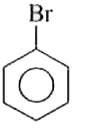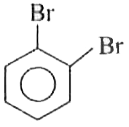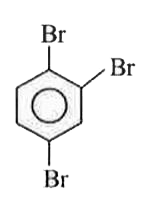Identify the compounds A,B and C in the following reactions.
(i) C6H5NH2NaNO2,HCl−−−−−−−→273−278KACuBr/HBr−−−−−−→B
(ii) C6H6conc.HNO3,conc.H2SO4−−−−−−−−−−−−−−−→<333KAH2/Ni−−−→B
(iii) C6H5NO2Fe/HCl−−−−→ANaNO2/HCl−−−−−−−→273−278K
(iv). C6H5NO2Sn+HCl−−−−−→ANaNO2+HCl−−−−−−−−→273KBH2O/H+−−−−−→Δ
To identify the compounds A, B, and C in the given reactions, we will analyze each reaction step-by-step.
Step 1: Analyzing Reaction (i)
Given Reaction:
C6H5NH2273−278K,NaNO2,HCl−−−−−−−−−−−−−−→ACuBr/HBr−−−−−−−→B
1. Starting Compound:
- The starting compound is aniline, C6H5NH2.
2. Reaction with NaNO2 and HCl:
- Aniline reacts with sodium nitrite (NaNO2) in the presence of hydrochloric acid (HCl) to form benzene diazonium chloride, C6H5N2Cl (Compound A).
3. Reaction with CuBr/HBr:
- The benzene diazonium chloride then reacts with copper(I) bromide (CuBr) in the presence of hydrobromic acid (HBr) to form bromobenzene, C6H5Br (Compound B).
Step 2: Analyzing Reaction (ii)
Given Reaction:
C6H6<333K,conc.HNO3,conc.H2SO4−−−−−−−−−−−−−−−−−−−→AH2/Ni−−−−→B
1. Starting Compound:
- The starting compound is benzene, C6H6.
2. Nitration Reaction:
- Benzene reacts with concentrated nitric acid (HNO3) and concentrated sulfuric acid (H2SO4) to form nitrobenzene, C6H5NO2 (Compound A).
3. Reduction Reaction:
- Nitrobenzene is then reduced using hydrogen gas (H2) in the presence of nickel (Ni) to form aniline, C6H5NH2 (Compound B).
Step 3: Analyzing Reaction (iii)
Given Reaction:
C6H5NO2Fe/HCl−−−−−→A273−278K,NaNO2/HCl−−−−−−−−−−−−−−−→B
1. Starting Compound:
- The starting compound is nitrobenzene, C6H5NO2.
2. Reduction Reaction:
- Nitrobenzene is reduced by iron (Fe) in the presence of hydrochloric acid (HCl) to form aniline, C6H5NH2 (Compound A).
3. Diazotization Reaction:
- Aniline then reacts with sodium nitrite (NaNO2) and HCl to form benzene diazonium chloride, C6H5N2Cl (Compound B).
Step 4: Analyzing Reaction (iv)
Given Reaction:
C6H5NO2Sn+HCl−−−−−→A273K,NaNO2+HCl−−−−−−−−−−−−→BΔ,H2O/H+−−−−−−−→C
1. Starting Compound:
- The starting compound is nitrobenzene, C6H5NO2.
2. Reduction Reaction:
- Nitrobenzene is reduced by tin (Sn) in the presence of hydrochloric acid (HCl) to form aniline, C6H5NH2 (Compound A).
3. Diazotization Reaction:
- Aniline then reacts with sodium nitrite (NaNO2) and HCl to form benzene diazonium chloride, C6H5N2Cl (Compound B).
4. Hydrolysis Reaction:
- The diazonium salt undergoes hydrolysis upon heating (Δ) in water with acid to form phenol, C6H5OH (Compound C).
Summary of Compounds
- Reaction (i):
- A = Benzene diazonium chloride (C6H5N2Cl)
- B = Bromobenzene (C6H5Br)
- Reaction (ii):
- A = Nitrobenzene (C6H5NO2)
- B = Aniline (C6H5NH2)
- Reaction (iii):
- A = Aniline (C6H5NH2)
- B = Benzene diazonium chloride (C6H5N2Cl)
- Reaction (iv):
- A = Aniline (C6H5NH2)
- B = Benzene diazonium chloride (C6H5N2Cl)
- C = Phenol (C6H5OH)
Given Reaction:
C6H5NH2273−278K,NaNO2,HCl−−−−−−−−−−−−−−→ACuBr/HBr−−−−−−−→B
- The starting compound is aniline, C6H5NH2.
2. Reaction with NaNO2 and HCl:
- Aniline reacts with sodium nitrite (NaNO2) in the presence of hydrochloric acid (HCl) to form benzene diazonium chloride, C6H5N2Cl (Compound A).
3. Reaction with CuBr/HBr:
- The benzene diazonium chloride then reacts with copper(I) bromide (CuBr) in the presence of hydrobromic acid (HBr) to form bromobenzene, C6H5Br (Compound B).
Given Reaction:
C6H6<333K,conc.HNO3,conc.H2SO4−−−−−−−−−−−−−−−−−−−→AH2/Ni−−−−→B
- The starting compound is benzene, C6H6.
2. Nitration Reaction:
- Benzene reacts with concentrated nitric acid (HNO3) and concentrated sulfuric acid (H2SO4) to form nitrobenzene, C6H5NO2 (Compound A).
3. Reduction Reaction:
- Nitrobenzene is then reduced using hydrogen gas (H2) in the presence of nickel (Ni) to form aniline, C6H5NH2 (Compound B).
Given Reaction:
C6H5NO2Fe/HCl−−−−−→A273−278K,NaNO2/HCl−−−−−−−−−−−−−−−→B
- The starting compound is nitrobenzene, C6H5NO2.
2. Reduction Reaction:
- Nitrobenzene is reduced by iron (Fe) in the presence of hydrochloric acid (HCl) to form aniline, C6H5NH2 (Compound A).
3. Diazotization Reaction:
- Aniline then reacts with sodium nitrite (NaNO2) and HCl to form benzene diazonium chloride, C6H5N2Cl (Compound B).
Given Reaction:
C6H5NO2Sn+HCl−−−−−→A273K,NaNO2+HCl−−−−−−−−−−−−→BΔ,H2O/H+−−−−−−−→C
- The starting compound is nitrobenzene, C6H5NO2.
2. Reduction Reaction:
- Nitrobenzene is reduced by tin (Sn) in the presence of hydrochloric acid (HCl) to form aniline, C6H5NH2 (Compound A).
3. Diazotization Reaction:
- Aniline then reacts with sodium nitrite (NaNO2) and HCl to form benzene diazonium chloride, C6H5N2Cl (Compound B).
4. Hydrolysis Reaction:
- The diazonium salt undergoes hydrolysis upon heating (Δ) in water with acid to form phenol, C6H5OH (Compound C).
- Reaction (i):
- A = Benzene diazonium chloride (C6H5N2Cl)
- B = Bromobenzene (C6H5Br)
- A = Nitrobenzene (C6H5NO2)
- B = Aniline (C6H5NH2)
- A = Aniline (C6H5NH2)
- B = Benzene diazonium chloride (C6H5N2Cl)
- A = Aniline (C6H5NH2)
- B = Benzene diazonium chloride (C6H5N2Cl)
- C = Phenol (C6H5OH)
Topper's Solved these Questions
- BOOK - PRADEEPCHAPTER - ORGANIC COMPOUNDS CONTAINING NITROGENEXERCISE - ADDITIONAL QUESTIONS (LONG ANSWER QUESTIONS)7videos
ORGANIC COMPOUNDS CONTAINING NITROGEN
- BOOK - PRADEEPCHAPTER - ORGANIC COMPOUNDS CONTAINING NITROGENEXERCISE - HIGHER ORDER THINKING SKILLS (HOTS QUESTIONS)7videos
ORGANIC COMPOUNDS CONTAINING NITROGEN
- BOOK - PRADEEPCHAPTER - ORGANIC COMPOUNDS CONTAINING NITROGENEXERCISE - ADDITIONAL QUESTIONS (VERY SHORT ANSWER QUESTIONS)59videos
ORGANIC COMPOUNDS CONTAINING NITROGEN
- BOOK - PRADEEPCHAPTER - HALOALKANES AND HALOARENESEXERCISE - IMPORTANT QUESTIONS FOR BOARD EXAMINATION22videos
HALOALKANES AND HALOARENES
- BOOK - PRADEEPCHAPTER - P-BLOCK ELEMENTS EXERCISE - IMPORTANT QUESTIONS FOR BOARD EXAMINATION25videos
P-BLOCK ELEMENTS
Similar Questions
If electronegativity of element A,B,C & D are 1.2, 3, 1.8 & 2.8 respectively then which of the following hydroxide is most basic in nature in aqueous solution:- Question Type: Single Correct Type
(1) A-O-H
(2) B-O-H
(3) C-O-H
(4) D-O-HView SolutionGive the structures of A, B and C in the following reactions
(i) CH3CH2INaCN−−−→AOH−−−−−−−−−−−−→hydrolysis PartialBNaOH+Br2−−−−−−−→C
(ii) C6H5N2ClCuCN−−−→AH2O/H+−−−−−→BNH3−−−−−→ΔC
(iii) CH3CH2BrKCN−−→ALiAlH4−−−→BHNO2−−−→0∘CC (iv) C6H5NO2Fe/HCl−−−−→ANaNO2+HCl−−−−−−−−→273KBH2O/H+−−−−−→ΔC
(v) CH3COOHNH3−−→ΔANaOBr−−−→BNaNO2/HCl−−−−−−−→C
(vi) C6H5NO2Fe/HCl−−−−→AHNO2−−−→273KBC6H5OH−−−−→CView Solution
Knowledge Check
- Question 1 - Select One
Identify Y in the following reaction, C6H5NH2NaNO2/HCl−−−−−−−→280KXCuBr/HBr−−−−−−→Y
A B
B C
C D
D
- Question 2 - Select One
The final product in the following sequence of ractions is C6H5NH2NaNO2/HCl−−−−−−−→273−278KAC6H6/NaOH−−−−−−−−→B
AC6H5N2ClBC6H5OHCC6H5−C6H5DC6H5N=NOH - Question 3 - Select One
Identify y in the following reaction,
C6H5NH2NaNO2/HCl−−−−−−−→(280K)XCuBr/HBr−−−−−−→YA B
B C
C D
D
Identify the product C in the series.
C6H5NO2FeHCl−−−→ANaNO2+HCl−−−−−−−−→273KBH2O−−→283CView SolutionThe final product in the following sequence of reaction is
C6H5NH2NaNO2+HCl−−−−−−−−→273−278KANaOH−−−→BView SolutionIn the reaction
C6H5NH2NaNO2/HBF4−−−−−−−−−→273k(A)ΔH−−→C6H5FView SolutionIdentify 'C' in the following sequence :
C6H5NH2NaNO2+HCl−−−−−−−−→273KACuCN−−−→BLiAIH4−−−−→CView SolutionC6H5−NH2NaNO2/HCl−−−−−−−→0∘CACuCl2/HCl−−−−−−−→B, is
View Solution

